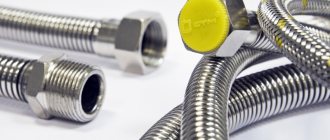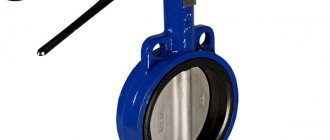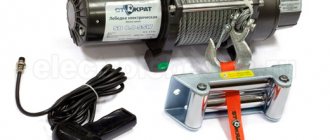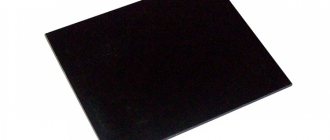When approaching renovations in a kitchen where there is a gas stove, one of the first questions that needs to be resolved is what to do with the gas distribution? I would like, for example, to rearrange the stove or, as an option, install a separate hob and oven. Do I need to make a gas supply from welding pipes for this, or can I use a flexible hose? What can be its maximum length? We are publishing explanations from a specialist from MOSGAZ OJSC on this topic.
How long can a flexible hose be for connecting a gas stove (oven and hob)?
Question: Good afternoon. I have a question: what is the maximum length of a flexible hose for connecting a gas stove, which ones can be used? Thank you.
Answer: Dear Lyudmila Valerievna! In response to your request dated February 18, 2016, MOSGAZ OJSC reports the following.
According to clause 3.21 of the Moscow standard for the operation of the housing stock ZHM-2004/03 “Gas pipelines and gas equipment of residential buildings”, approved and put into effect by Decree of the Moscow Government dated November 2, 2004 No. 758-PP, connecting gas appliances to the gas pipeline is allowed through a flexible connection, having no butt joints and having a heat resistance of at least 120 degrees.
Flexible liner should be:
- accessible for inspection and maintenance;
- should not be pinched by anything, have kinks or experience tensile forces;
- It is not allowed to lay it in places where it may be susceptible to corrosion, namely behind a sink, in places where it is possible to be washed by combustion products or come into contact with heated metal.
The length of the flexible line depends on the installation location of the disconnecting device. The shut-off valve is installed on a horizontal section of the gas pipeline, at a distance of at least 20 cm from the side of the stove. For overhead wiring, the shut-off valve should be installed on the descent to the slab at a height of 1.5 -1.6 m from the floor.
Service staff can offer installation of flexible hoses up to 3.0 meters in length.
Not so long ago, owners didn’t even have a question about which hose to choose for a gas stove. In Soviet times, these household appliances were tightly connected to the gas pipeline with steel pipes. It was simple, reliable, safe, but inconvenient: the slab could not be moved even a millimeter after installation. With the advent of the new product, it became possible to connect the stove using a flexible hose, thanks to which the device can be rearranged or temporarily moved if necessary.
p, blockquote 1,0,0,0,0 –>
Never use gas hoses without the appropriate markings, permission from Rostekhnadzor of Russia for their use, as well as certificates of compliance with SNIP and GOST. It is mandatory to have a flexible hose passport, which indicates the date of manufacture, service life and replacement of the hose.
It is advisable to check in advance with the gas company in your city about the technical conditions for connecting gas stoves. This may refer to the maximum length of the liner, the way it is attached and the materials from which it should be made.
p, blockquote 2,0,0,0,0 –>
Oxygen
Oxygen hoses were often used in Soviet times, since there were simply no other options for connecting via flexible hoses. Now this product fades into the background. Cost - from 60 rubles per linear meter without tips.
p, blockquote 8,0,0,0,0 –>
p, blockquote 9,0,0,0,0 –>
- ability to withstand high pressure (up to 20 atmospheres);
- ease of installation;
- cheapness;
- does not conduct electricity;
- can be selected to suit any pipe diameter.
p, blockquote 10,0,1,0,0 –>
At the same time, oxygen products are short-lived and require careful attention:
It is important to remember that the oxygen connecting hose is not a special gas hose; it is needed for other purposes, so it is better not to use it unless absolutely necessary.
Rubber-fabric
The cheapest of specialized components from 120 rubles for 0.5 meters with tips (finished product). The rubber-fabric hose has:
p, blockquote 13,0,0,0,0 –>
- relatively short service life, on average from 5 years depending on the quality of the materials used;
- insufficient level of rigidity;
- low permissible temperature;
- product length from 0.4 to 7 meters.
Read also: Is it possible to drill with a wrench
p, blockquote 14,0,0,0,0 –>
Otherwise, it’s a good option for connecting a stove, which has its advantages:
p, blockquote 15,0,0,0,0 –>
- high level of electrical insulation;
- wide range (easy to find for any pipes);
- Thanks to its softness, it can be easily trimmed to suit existing conditions.
You can install the product yourself, but it is better to contact a specialist.
With metal braid
It has an optimal ratio of price, quality and durability. Price from 140 rubles per 60 cm of finished product. The hose is made of vulcanized rubber and reinforced with textile thread. The outer part is a metal braid.
p, blockquote 17,0,0,0,0 –>
The gas hose is similar to the water supply (for the toilet, taps, shower). You can distinguish it by markings: plumbing products have blue and red marks for cold and hot water, and a yellow thread is woven into the braid of gas products.
p, blockquote 19,0,0,0,0 –>
One of the most common options, the popularity of which is associated with many positive qualities, including:
p, blockquote 20,1,0,0,0 –>
- high level of reliability;
- ease of installation;
- longer service life compared to rubber products;
- large selection of lengths and diameters;
- permissible temperature has a wide range from -35 to + 50 degrees;
- ease of use.
It is prohibited to use the product without installing a dielectric insert!
Reinforced hoses: polymer, rubber, steel
Polymer materials are located inside such a hose. The next layer is vulcanized rubber. On the outside, it is braided with steel threads. In order not to confuse the products with similar water hoses, a yellow thread is woven into them.
Reinforced hoses are quite popular, the reasons for which are:
- simple installation and ease of operation;
- reliability and decent shelf life;
- variety of assortment - both in diameter and length;
- safe use at temperatures from -35° to +50°.
Let us also note a significant disadvantage - the unimportant level of electrical insulation, the culprit of which is the metal braid. Therefore, when installing, you usually have to insert a dielectric coupling between the plate and the supply line. There is another drawback - the unreliability of the internal polymer material. For this reason, they have become “persona non grata” in some European countries, and recently the same trend has been emerging in our country.
PVC reinforced
PVC gas line is one of the latest developments. It does not conduct electricity, does not break down like rubber, and is almost as durable as a bellows hose. It has 2 layers: an inner one made of black PVC, and an outer shell made of yellow PVC. Due to their novelty, not all gas services accept them for operation, so it is better to consult an authorized organization in advance. Price for 60 cm of product - from 140 rubles.
p, blockquote 22,0,0,0,0 –>
p, blockquote 23,0,0,0,0 –>
Properties of reinforced PVC hoses:
p, blockquote 24,0,0,0,0 –>
- flame retardant;
- dielectric;
- withstands hot plate contact test;
- quite cheap with a comparable service life;
- resistant to oil mist;
- operated under conditions of increased loads;
- meets the requirements of GOST R 52209-2004, GOST12.2.063-81, GOST12.2.003-91;
- guaranteed service life - 12 years, actual service life - more than 20 years;
- length from 60 cm to 5 m.
Bellows
Bellows tubes are most often recommended by gas equipment installation specialists. This option is the most reliable and most expensive. But given the very long service life (up to 30 years), its cost is justified. Price from 170 rubles for 60 cm of finished eyeliner.
p, blockquote 25,0,0,0,0 –>
Bellows (from the English brand name Sylphon) is an elastic single-layer or multi-layer corrugated shell made of metal, non-metallic and composite materials that maintains strength and tightness under high-cycle deformations of compression, tension, bending and their combinations under the influence of internal or external pressure, temperature and mechanical stress . (https://ru.wikipedia.org/wiki/Bellows)
The bellows hose is made of stainless steel, with a PVC coating on top. This ensures that it will last a long time: the average lifespan is 25–30 years. The metal braid reliably protects from mechanical influences, and the polyvinyl chloride coating provides electrical insulation and resistance to chemicals. Thanks to the corrugated surface, the product bends easily.
p, blockquote 27,0,0,0,0 –>
p, blockquote 28,0,0,0,0 –>
Bellows gas hose has the following advantages:
p, blockquote 29,0,0,0,0 –>
- can be connected to any gas equipment: stoves, boilers, etc.;
- has connecting dimensions 1/2″, 3/4″, 1″;
- has excellent flexibility;
- withstands pressure up to 6 atmospheres;
- wide range of operating temperatures: from -50 to +250 degrees (installation outdoors is allowed; nothing will happen to it if it comes into contact with hot surfaces);
- able to withstand mechanical loads, aggressive environmental influences, and household chemicals;
- hoses comply with the requirements of GOST R 52209-2004, GOST12.2.063-81, GOST12.2.003-91;
- warranty service life - up to 15 years;
- service life – up to 30 years;
- is able to ensure the tightness of the system even under extreme loads, for example, during an earthquake.
The length of the bellows gas hose varies depending on the manufacturer.
p, blockquote 30,0,0,1,0 –>
With Emiflex, the eyeliner can increase in size by 2 times and has the following parameters (in meters):
p, blockquote 31,0,0,0,0 –>
- from 0.26 to 0.52;
- from 0.5 to 1.0;
- from 0.75 to 1.5;
- from 1.0 to 2.0.
And the hoses have a fixed length (in meters):
The only thing that can scare off a buyer is the price. But considering its durability, it is the most profitable purchase.
Do not use the hose without installing a dielectric insert!
p, blockquote 34,0,0,0,0 –>
Bellows hoses: the favorite among specialists
The greater reliability of bellows hoses is the reason for their indecently high price. They are made of stainless steel and covered with polyvinyl chloride on top. These products can guarantee your safety for 25-30 years, and this figure is an average value.
The corrugated surface and metal braid provide protection from mechanical damage, and resistance to chemicals and electrical insulation are provided by the PVC coating. Let's list all the advantages:
- Widely used to connect any equipment;
- impressive temperature range - from -50° to +200°;
- ability to withstand pressure of 6 atmospheres;
- guarantees preservation of tightness even in extremely unfavorable conditions.
The only downside is the price, which is 5 times more than other hoses. But if we take into account the service life and ultra-reliability of these hoses, then we can assume that the product will quickly pay for itself.
Rules for choosing a gas hose
A few simple tips will help you choose a gas hose, save time and money, and avoid troubles with energy leaks:
p, blockquote 35,0,0,0,0 –>
- Buy any products only in specialized stores, and do not forget to ask the seller for a quality certificate.
- You cannot buy Chinese hoses: they are thin and quickly become unusable. There are also many fakes.
- The slabs are connected only with those sleeves that have a special yellow mark. They cannot be replaced with plumbing ones. The latter are not designed for such loads and wear out in a few weeks.
- When purchasing, the eyeliner must be carefully inspected for damage.
- Select the size so that the product sags and does not stretch.
- Pay attention to the mounting methods - fitting or nut - select them according to size.
Important! For a stove with electric ignition, you need to buy a fireproof flexible liner with insulators in the form of white plastic rings between the nuts and braid, or use a dielectric insert.
p, blockquote 37,0,0,0,0 –>
Read also: Two switches for two light bulbs connection diagram
Types of gas taps
In old buildings, two types of cranes were usually installed on vacation:
- petal;
- suberic.
The differences between the designs of these products can be seen in the figure.
When the slab is replaced or the valve fails, it is best to install a new ball valve.
This device is much better, but more expensive. Installation of an Italian faucet will cost $10. You can also install a cheaper domestic faucet, costing $5. They are no worse than their foreign counterparts, but sometimes have defects. Therefore, do not forget to take a receipt with you when purchasing so that you can exchange the defective product for a good one.
Installation recommendations
When installing the hose, use the following recommendations:
p, blockquote 38,0,0,0,0 –>
- The hose must be laid in an easily accessible place. It is not safe to hide it in a wall or under the floor.
- The bending radius should not be less than three times its diameter.
- The product must not be pulled, twisted, bent, or painted.
- Metal parts must be protected from condensation, which leads to oxidation of the material.
- You cannot connect steel elements (tips) with copper ones, this can lead to electrolytic damage to the product. Acceptable combinations are steel with steel, brass with copper.
- All connections must be tightened tightly, but without excessive force, so as not to damage the threads.
- A dielectric insert is installed between the tap and the gas hose, which prevents the accumulation of stray currents, which can lead to overheating of the braid, damage to the device, and melting of the rubber.
Gas stove connection diagram
How to properly connect a gas stove? This is not difficult if you have a diagram. It is almost always performed using the same technology.
There is a gas pipe running through your apartment. It connects with neighbors living upstairs and downstairs. It's called a boner. In each apartment, another pipe departs from the riser, ending with a tap. It is this branch that connects to your gas appliance. Gas workers call such a pipe a release.
A gas meter is installed between the tap and the riser. We won't talk about it for now. The thread diameter of the tap installed at the end of the release is 1/2′ or DN15.
A special gas hose is screwed into the tap. There should be no slips or unnecessary connections. Gas must be supplied through the hose to a specific device.
In older houses, the gas stove is connected to an iron pipe. This causes a lot of inconvenience. The stove cannot be moved or rearranged. This type of connection scheme is no longer practiced by professionals. They will definitely supply a flexible hose if they are replacing the slab. Today, the most convenient connection for gas appliances is considered to be a scheme that uses rubber-fabric sleeves. Let's talk about this system in more detail.
Connecting the hose does not look very complicated, but there are several nuances that must be taken into account.
Gas line service life
After installing the hose, you should check its service life and remember the installation date. The product, depending on the type, is designed for a period of 5 to 15 years. It is important not to forget to replace it on time.
p, blockquote 39,0,0,0,0 –> p, blockquote 40,0,0,0,1 –>
Guaranteed service life is indicated in the product passport and in the certificate of conformity.
- rubber hoses (with and without sheath) – 5-year warranty, service life up to 10 years;
- PVC eyeliner – 12-year warranty, lasts up to 20 years;
- bellows gas hose - 15 year warranty, does not require replacement up to 30 years.
The gas heating boiler is connected to the main line using a flexible hose.
Choosing and installing a hose for a boiler is a very important matter , because we are talking about gas.
An incorrect connection to the gas pipeline may result in an explosion .
To supply household gas, flexible gas hoses specially designed for this purpose are used. The use of water hoses for this purpose is strictly prohibited.
Safety regulations
Many users are completely incompetent in these matters, so it is our duty to remind them of the safety principles:
- the hose must be constantly accessible and visible - it must not be covered with foreign objects;
- In addition to it, only a wire for lighting in the oven should be connected to the stove;
- paint cannot be applied to its surface;
- the hose, when connected, should sag freely and not be in a tense position - this may cause it to rupture;
- when purchasing and installing this product, calculate in advance how far you will move the stove during general cleaning or when rearranging furniture in the kitchen, taking into account that its maximum length is no more than 4.5 meters;
- do not allow the product to bend or twist;
- It is better to replace the hose a little earlier than its service life, without waiting for a gas leak with negative consequences to occur.
Read also: What a novice electrician should know
When repairing a gas pipeline using welding, the product must be turned off, and the stove must be moved to the maximum distance, covering its back with a piece of durable fabric to protect it from sparks. The more carefully you use the hose, the more secure your kitchen will be. The rules for operating gas stoves are described in detail here. To reinforce the above, watch this video:
Gas hose, it would seem, what mystery could there be in this simplest product? Come to any hardware store, take it and go to the checkout. However, have you ever wondered what is the difference between a gas hose for a gas stove and a gas hose for a boiler?
And the most important thing is that on the shelves of large retail chains such as Leroy Merlin or Maxid, this product is presented in a huge assortment. The question inevitably arises: which gas hose is better to buy? On one tray there is a PVC gas hose reinforced with polyester thread, on the other there is a bellows-type gas hose, and even lower down there is a rubber hose, and how can you not get confused?
More recently, literally a couple of decades ago, you would not have worried about the question of how to connect a gas stove. All gas household appliances, after purchase, were “tightly” and securely connected, as a rule, by the foreman of their nearest housing office using a steel pipe. Of course, we didn’t even think about aesthetics or design. There was only one task - to start using the new device as soon as possible.
Connecting with a steel pipe undoubtedly has a number of advantages. Requirements such as strength, reliability, and safety are 100% ensured. There’s just one small inconvenience: the housewife most likely won’t be able to wash the floor under the stove for the next twenty years. And it’s impossible to find kitchen furniture of the right size, so there remains 20 centimeters on each side of the stove, but it is not possible to move it. Finally, this kind of problem is a thing of the past, and there has been no shortage on the domestic household market for a long time, and flexible gas supply is offered in a wide range.
Choosing a gas hose for a stove, water heater or boiler is a very serious step. The lives of many people depend on its strength, reliability and safety. Often, the result of an illiterate connection of a stove or gas water heater to communications is an explosion. For flexible supply of natural gas, only special gas hoses are used. It is strictly prohibited to use tap water for this purpose.
Of course, it is better to call a specialist who will provide a professional connection and give a guarantee. Each of us has seen in the news what household gas explosions lead to, including as a result of unqualified connections of household gas appliances. We know from childhood that we cannot joke with gas. However, a modern gas hose allows you to make the connection yourself. Adhering to basic safety rules, any adult man can perform such a procedure.
So, let's go to the store. Let's see what the seller offers there, which flexible gas hose to choose and buy for a gas stove? It turns out there are three main types of gas hoses used in everyday life:
- – rubber-fabric;
- – reinforced rubber;
- - bellows.
Varieties
three types used in everyday life :
- Rubber-fabric.
- Rubber reinforced.
- Bellows.
They are made from various materials, have different technical properties and service life. Each of the three types of gas hoses has both pros and cons. The choice depends on the installation location and the specific case.
Rubber
Rubber hoses reinforced with textile thread are the softest among all types of hoses. They are economical, easy to install and maintain. A wide selection of hoses of this type is available in construction stores. You can easily choose a sleeve of the desired length and diameter .
Photo 1. Rubber soft gas hose, black, is economical and easy to connect.
Rubber gas hose is mainly used in dachas. This method of gas supply is the most affordable and easy to install, but also the most unsafe. Over time, the rubber cracks, which inevitably leads to gas leakage, so the use of this type of connection is only permissible for private sector gas cylinders.
In addition, these hoses lack rigidity and are sensitive to temperature changes. This type of hose is recommended to be replaced every two years, however, in practice they are used much longer. Modern sleeves with elastic components can last up to 5 years .
Reinforced
Much more common are reinforced rubber hoses, which are similar to water supply hoses. They are braided with steel threads on the outside. The inside is made of polymer material, although they are called rubber.
Reinforced hoses are also affordable and easy to use, but they are prohibited in several European countries . Our gas specialists also do not recommend using them or doing so in compliance with a number of rules.
Photo 2. Two reinforced hoses made of polymer material, one covered with corrugated steel on top.
The polymer sleeve inside is destroyed in the same way as the rubber one. In addition, steel is an excellent conductor of current, so it is necessary to use dielectric spacers during installation. When using metal-braided tubes, be sure to turn off the gas taps; this will extend the service life of the hoses. This type of hose can be used at temperatures up to +50 degrees.
Read also: Assembling an electrical panel for a private house 380V 15kW
Bellows type stainless steel
This is the only type of gas hose approved for household use. It is a dense corrugated braid that is resistant to high and low temperatures, high pressure and mechanical stress. There is a single-layer and multi-layer bellows.
It is made from both metallic and non-metallic materials. The shell creates increased safety; it prevents damage from most types of impacts.
Photo 3. The bellows gas sleeve is yellow, made of non-metallic material, coated with polymer.
This type of hose is made of stainless steel. Gas hoses are sold with and without insulation. The second type is coated with a polymer that does not conduct electricity. A hose with a diameter of at least 10 cm for uniform gas supply. Bellows hoses are an order of magnitude better in quality than others.
Reference! The most reliable samples are those with a polymer coating that protects them from environmental influences. These gas hoses last up to 30 years , they are safer, but also more expensive.
Advantages of bellows hoses for gas:
Advantages and disadvantages of bellows
A wide range of hoses for gas stoves made of elastic polymers and rubber are on sale. In comparison with them, the flexible bellows connection has the following features:
- A corrugated metal hose is difficult to damage with sharp objects; in this respect, it is superior to similar hoses made of polymers and rubber.
- The metal sleeve conducts electricity well. Therefore, during installation, in order to avoid problems with electricity leaks in the stove and protect against stray currents, it is connected through a dielectric adapter coupling.
- The bellows are stiffer and harder than polymers, so its bending radius is slightly larger.
- Also, when moving a slab with a bellows liner, care must be taken - the shell may crack if subjected to sudden tension or bending.
- But the rigidity of the bellows sleeve also has certain advantages. For example, it can be placed in any spatial position convenient for the user.
- Due to the ribbed surface, corrugated pipes are quite difficult to maintain. The cleaning procedure is greatly simplified if the bellows is equipped with an outer polymer shell.
- The cost of bellows hoses made of stainless steel is higher than that of rubber or polyvinyl chloride analogues.
- Corrugated stainless steel pipe, unlike rubber and polymers, is not subject to physical aging, changes in the structure of the material, or cracking.
- It is worth noting that many users complain that the bellows connections in their water supply and heating networks operate for a relatively short period of time (maximum 2 - 3 years). This is due to the fact that the corrugated metal hose has high rigidity and is not very suitable for working with constant stresses in the form of water hammer due to pressure drops in networks with a liquid medium. Therefore, if you do not move the gas stove every day and take into account the low pressure of the medium in the network, a corrugated stainless steel hose connected to the main line can be used for at least 10 years.
How to choose the right flexible gas tube?
It is safest to purchase a gas hose in a specialized store that has a state certificate of conformity . It is best to opt for the bellows type of sleeve.
Important! Beware of fakes of poor quality. There is a high probability of purchasing counterfeit goods on the market. This threatens that the sleeve will be made of thin, cheap rubber, which will quickly fail. Most fakes can only be distinguished from the original by a professional.
To identify a counterfeit, you need to carefully study the technical characteristics of the product, passport and certificate of conformity. You should not buy a product at a suspiciously low price.
Before purchasing, you need to take a measurement, then add 20% . You should not purchase a gas hose with a reserve. Standard sizes are 1–2 m. In everyday life, diameters of 1/2 or 3/4 inches are usually used.
The hose comes with two types of fastenings: with two union nuts with internal threads (female-female) or with a nut on one end and a fitting on the other (female-male). The thread is selected depending on the outlet on the device. It is preferable to opt for welded structures rather than those where the fitting is connected to the corrugation with glue.
Installation
The safest thing to do is contact a professional who will ensure the correct connection and provide a guarantee. After all, everyone knows from childhood that it is dangerous to joke with gas.
An unqualified connection to a gas pipeline can lead to an accident; everyone has seen the consequences of a domestic gas leak in the news.
However, a modern gas hose allows you to independently connect the boiler to the mains. Any adult can carry out installation while observing safety precautions
When working, you must adhere to the following rules:
- The length of the line is selected taking into account the distance over which the equipment is likely to be moved.
- The system is located in a place accessible for inspection.
- There must be no other connections on the device
- The product cannot be painted to avoid cracking of the material.
- The dimensions of gas hoses must comply with GOST standards.
- Do not twist, bend or strain the sleeve.
- Do not solder or weld the connection.
- Replace the hose with a new one in accordance with the manufacturer's recommendations.
Connection to the gas pipeline
To install the gas hose to the riser you will need an adjustable wrench, a screwdriver, a sealant, a brush and a soap solution.
First you need to prepare the room and shut off the gas supply to the network. Then the boiler is installed at the installation site and carefully leveled.
Each apartment has a gas riser , which has branches with taps at the ends, this is called a release.
A sealant is applied to the hose fitting and screwed into the tap during release. If the diameters do not match, then an adapter is needed, which is also sealed. The hose is connected to the boiler.
The system is then tested for leaks. To do this, use a brush to apply a soap solution to the joints and slightly unscrew the valve. If the connection is leaky, the solution will begin to bubble, otherwise nothing will happen. If a leak is detected, it is necessary to turn off the gas and check the winding of the seal.
Lastly, the equipment is checked for functionality and gas is supplied.
Attention! If you have any doubts, the best solution is to contact a specialist. The technician will connect the gas safely, reliably and in compliance with all regulations, and will also guarantee the correct operation of the system for many years.
What do you need to consider for connection security?
Gas is not something to joke about, so it is better to entrust the work to a professional who is familiar with all the nuances. But if you familiarize yourself with the basic rules, you will be able to control its work from the outside, and when the opportunity arises, you will be able to show off the knowledge you have acquired. So:
- In order not to encounter problems in the future, you need to estimate in advance how far you are going to pull out the stove in case of, for example, cleaning. The length of the required hose depends on this.
- The product must be visible so that it can be constantly checked.
- Excessive tension, bending and twisting are unacceptable.
- Exposure to high temperatures is excluded.
- The elements are connected to each other only this way: copper to brass, steel to steel.
- They are tightened tightly, but not too enthusiastically, otherwise the thread may be damaged.
Read also: VVGBM cable APG decoding
Now you have learned about gas hoses for gas stoves: which one is best for you? If you value reliability and durability, then there is only one way out - buy a bellows product that will provide you with safety, and therefore comfort for a long time.
Please check out this review:
In the last century, the connection of gas stoves was carried out only by laying steel pipes, which was fully consistent with the current rules for the installation and operation of gas equipment. The slab was installed rigidly - it was no longer possible to move it. With the advent of imported household appliances and accompanying accessories, flexible products began to appear in specialized stores selling gas stoves, which were a curiosity for our consumers. But over time, a hose for connecting a gas stove appeared in almost every home and became an alternative to steel pipes due to its obvious advantages and convenient use.











